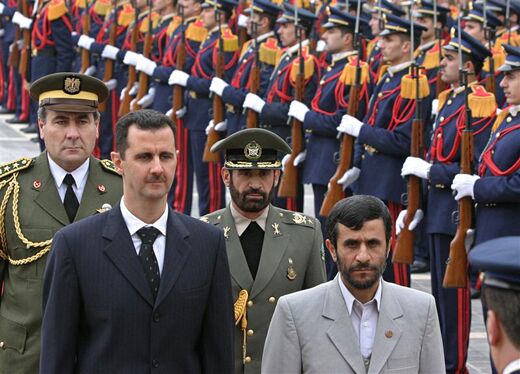
Imperial Iran
Iran is positioning itself to control the Middle East. One clear example of this behavior today is found in its relationship with Syria.
For many years, Syria allied with Iran, but resisted its neighbor’s religious overtures. In 1986, Syria’s defense minister told a reporter: “Syria is Syria and Iran is Iran. We cannot live like them and they cannot live like us. But we can work together.” Thus, even while Syria accepted Iranian money and support, there was always resistance to the importation of Iranian ideology and government.
Today, that resistance is rapidly coming to an end.
The Jerusalem Post claims that Tehran strategists “regard Lebanon and Syria as part of the Iranian glacis,” notably in any conflict with Israel (November 1).
Consider the steps Iran has taken to destabilize sectors of those two societies that might be unfriendly to the spread of Khomeinism. Last year, Iran sponsored a campaign to “cast suspicion on elements in the Syrian Ba’ath known for their opposition to Khomeinism. Hundreds of Ba’athist cadres, including senior figures, were retired or driven into exile” (ibid.). Those men were replaced, largely, by men with Iranian experience and training. As a result, Syrian President Bashar Assad himself is increasingly relying for his personal security on the Iranians and the Iran-backed Hezbollah.
Last June, Syria signed a defense pact that “gives Iran direct access to the Syrian military at middle and senior levels, provides for joint staff conversations, harmonization of weapons systems and training, and military exercises. Under it, any attack on either partner would be regarded as an aggression against the other. One result of the pact has been a fourfold increase in the number of Iranian military and security personnel in Syria” (ibid.).
A former member of President Assad’s cabinet warns that “Iran is trying to play the role that the Soviet Union played in Syria during the Cold War” (ibid.). In addition to spreading its brand of Islam, Iran seeks political ascendancy over its neighbor.
Though Syria is traditionally a mostly Sunni country, Geostrategy Direct reports that President Assad has given Iran the go-ahead to spread the Shiite religion in his country. In August, Iran opened two centers that teach Farsi in the port of Latakia. The Reform Party of Syria says there is a dangerous trend of non-Shia turning to Khomeini-style Shia teaching for economic rewards: “Whole villages and urban areas are adopting the Hezbollah model whereby clinics, schools and social services are provided by Iran in return for Syrians to convert to Shiism” (November 8). This is accomplished through charities modeled after those run by Hamas and Hezbollah; 41 Iranian-backed charities have appeared in Syria.
The president lifted bans on Syrians attending Islamic seminaries in Iran and on Iranian cultural centers in Syria: 11 centers for Khomeinist indoctrination have opened in Syrian cities; 17,000 Syrians enrolled in classes. A ban on Shiite proselytization also was lifted, allowing hundreds of mullahs to convert Sunnis to Shiism.
The number of Iranians allowed to visit the Zeynabiah Shiite holy shrine near Damascus has increased from 150 to 1,000 a day—quite possibly a cover for the presence of Islamic Revolutionary Guards.
Assad’s opponents claim he is modeling Syria after the success of Hezbollah, “logically calculating that if Hezbollah, with its 15,000 fighters and a God-like following of its figurehead Sheik [Hassan] Nasrallah, can achieve with $100 million a year the military prowess it exhibited against Israel then why not turn all of Syria into a larger Hezbollah laboratory in the hope of attaining the same results” (ibid.).
Meanwhile, the Sunni clerics in Syria are outraged at the dramatic change. Some say they would have to stand by Israel in a conflict just to protect their religion; no Sunni country is strong enough to protect them from Iran.
Outside of the religious sphere, the Jerusalem Post offered four additional proofs of Iranian meddling in Syria:
• Trade between Iran and Syria is mushrooming. Iran is expected to become Syria’s second major trading partner after the European Union this year. Hundreds of Iranian companies are now active in Syria.
• Non-Syrian Arabic media are banned in Syria, with one exception: Iranian tv and radio is available in every home in Syria.
• Iranian companies are offering cash gifts and preferential treatment in the job hunt for those who sport the Khomeini look: Khomeinist-style hijabs for the women and Khomeinist-style beards for the men.
• Iran is offering an unprecedented number of scholarships to Syrians: from 200 in 2001 to over 3,000 this year—including those for military training.
Syria needs Iranian support: It lost the $250 million annual stipend it received from Saudi Arabia when Lebanese Prime Minister Rafiq Hariri was murdered—along with any other moderate Arab support. Only the head of radical Islam—Iran—is backing President Assad’s regime now. Also, Iran has successfully convinced Syrians that it might be a target for regime change by the United States and that only militant Islam can stand against U.S. might, just as it stood against Israeli might in Lebanon during what Iran called Israel’s “greatest defeat.”
Thus, Syria is primed for Iran to exert unprecedented influence over its society. Expect to see that trend continued in Lebanon (where Iran finances Hezbollah) and Iraq (where reports of Iranian meddling in the government and religious spheres are endless). For more information of the development of Iranian power in the Middle East, read our booklet The King of the South.
